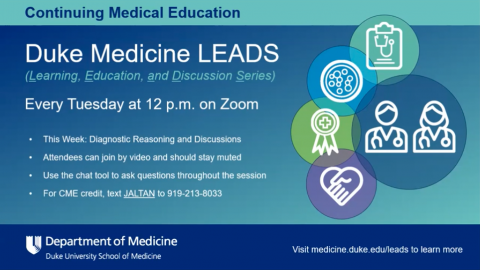Internal Medicine Chief Residents Announced for 2023-2024
Kathleen Cooney, MD, MACP, chair of the department, Aimee Zaas, MD, MHS, program director of the Duke Internal Medicine Residency Program, and David Simel, MD, vice chair for Veterans Affairs, have announced the Chief Residents for the 2023-2024 academic year.
School of Medicine is Third in Nation for Federal Medical Research Funding
Duke University School of Medicine was awarded more than $608 million in federal funding from the National Institutes of Health (NIH) in 2021, ranking third nationally among academic medical centers, up from 10th last year, according to the Blue Ridge Institute for Medical Research.
The Department of Medicine's award of that total was $174,530,472.
Orlando leads MeTree software recommended by President’s Cancer Panel
Dr. Lori Orlando leads the team behind MeTree and studies decision modeling and implementation science as it relates to identifying and managing individuals in clinical settings at increased risk for medical conditions.
Syed named Director of SOM Primary Care Leadership Track
Fatima Syed, MD, has been selected to serve as the new Director of the Primary Care Leadership Track (PCLT) at the School of Medicine.
Pearls from 1/25/2022 LEADS
The January 25, 2022, session of Duke Medicine LEADS featured Amit Patel, MD, Caroline Sloan, MD, Gabriela M. Maradiaga Panayotti, MD, and Daniella Zipkin, MD presenting "Patient Advocacy and Involvement in Governmental Affairs."
Pearls
GIM Faculty Spotlight: Katherine Neal, MD
Katherine Neal, MD, is an Assistant Professor of Medicine in the General Internal Medicine (GIM) division and a hospitalist at Duke University Hospital. Learn more in our interview!
Howard promoted to Assistant Professor
Congratulations to Dr. Howard for promotion to Assistant Professor of Medicine in the Division of General Internal Medicine, effective January 2, 2022
2021 GIM Excellence Award Winners
We are proud to announce the 6th annual GIM Excellence Awards, presented by our Division Chief, Dr. Ebony Boulware, in the video below. This year we have 7 different awards and 7 individual awardees as well as one team awardee.
A special thank you goes out to all those who submitted nominations for these awards.
Hospital Medicine Program Provides Significant Partnership in Clinical Care Delivery, Academic Research
Hospitalists have continued a growing and vital role in care delivery at Duke Health that includes a partnership with advanced practice provider (APP) teams and an emerging emphasis on academic research to improve outcomes.









